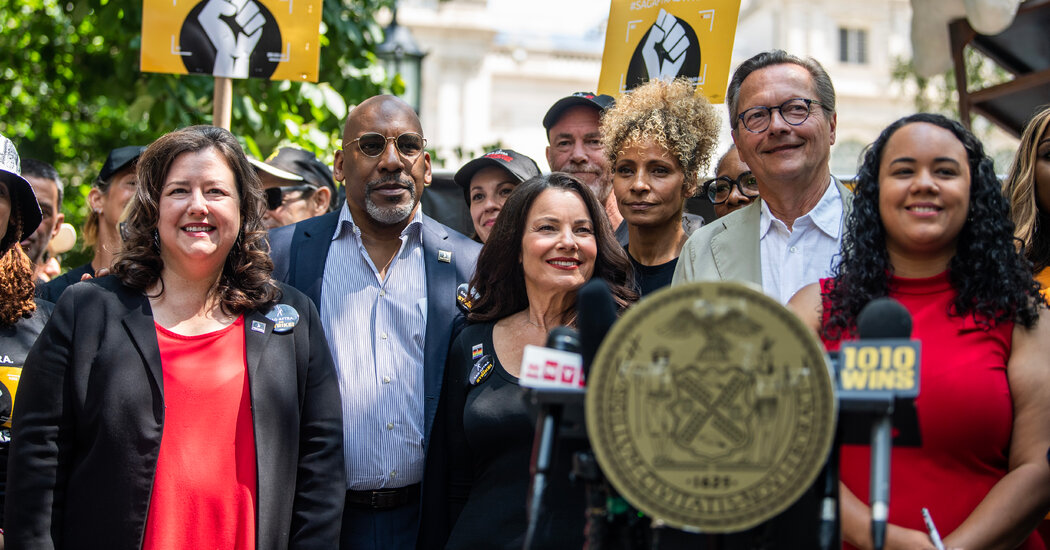The union that represents movie and television actors said on Friday that its 76-member national board had voted with 86 percent support to send a tentative contract with studios to members for ratification.
The ratification process will start on Tuesday and end the first week in December. Actors can go back to work immediately, however.
Members are expected to approve the contract, which Fran Drescher, the union’s outspoken president, valued at more than $1 billion over three years. She highlighted the “extraordinary scope” of the agreement, noting that it included protections around the use of artificial intelligence, higher minimum pay, better health care funding, concessions from studios on self-taped auditions, improved hair and makeup services on sets, and a requirement for intimacy coordinators for sex scenes, among other gains.
“They had to yield,” Ms. Drescher said at a news conference during a 28-minute monologue that touched on Veterans Day, Bela Lugosi’s Dracula costume, her parents, the Roman Empire, studio stubbornness, Buddhism, Frederick Douglass and her dog.
The union, SAG-AFTRA, which represents tens of thousands of actors, and the Alliance of Motion Picture and Television Producers, which bargains on behalf of studios, reached the tentative agreement on Wednesday. It followed a bitter standoff that contributed to a near-complete shutdown of production in the entertainment industry. At 118 days, it was the longest movie and television strike in the union’s 90-year history.
The tentative deal was also historic, according to the studio alliance, which said it reflected “the biggest contract-on-contract gains in the history of the union.” In a statement, the alliance said it was “pleased” that SAG-AFTRA’s board had recommended ratification.
“We are also grateful that the entire industry has enthusiastically returned to work,” the alliance said.
The actors’ strike, combined with a writers’ strike that started in May and was resolved in September, devastated the entertainment economy. Hundreds of thousands of crew members were idled, with some losing their homes and turning to food banks for groceries. Some small businesses that service studios — costume dry cleaners, prop warehouses, catering companies — may never recover.
The dual strikes caused roughly $10 billion in losses nationwide, according to Todd Holmes, an associate professor of entertainment media management at California State University, Northridge. While the big studios are based in Los Angeles, they also use soundstage complexes in Georgia, New York, New Jersey and New Mexico.
Kevin Klowden, chief global strategist with the Milken Institute, an economic think tank, was more cautious with his estimate, putting losses at more than $6 billion. He said it “may take a while” to know the true size.
On Friday, the SAG-AFTRA board, which includes Sharon Stone, Sean Astin and Rosie O’Donnell, made public a summary of the tentative contract’s contents. While not receiving everything it asked for, the union achieved significant gains.
The final sticking point involved “synthetic fakes,” or the use of artificial intelligence to create an entirely fabricated character by melding together recognizable features from real actors. The union won consent and compensation guarantees.
“You could imagine prompting a generative A.I. system that’s been trained on a bunch of actors’ performances to create a digital performer, for example, who has Julia Roberts’s smile,” Duncan Crabtree-Ireland, SAG-AFTRA’s executive director, said in an interview. “Before this agreement, there wasn’t any contractual or legal basis to require consent or prohibit that. Now there will be.”
But this strike was never about stars. A-listers like Jennifer Lawrence and Brad Pitt negotiate their own contracts (or, more precisely, their agents do). The tentative contract covers minimums, or what actors who don’t have any clout get paid.
SAG-AFTRA had demanded an 11 percent raise for minimum pay in the first year of a contract. Studios had insisted that they could offer no more than 5 percent, the same as had recently been given (and agreed to) by unions for writers and directors. In the end, the union was able to win a 7 percent first-year raise.
“This is really important because it sends a very clear signal to other unions,” Mr. Crabtree-Ireland said. “I’m not aware of anyone ever being able to break the pattern before, because it’s always been that the A.M.P.T.P. establishes a number and everyone gets held to it.”
SAG-AFTRA failed in one regard. It had gone into negotiations demanding a percentage of streaming service revenue. It had proposed a 2 percent share — later dropped to 1 percent, before a pivot to a per-subscriber fee. Ms. Drescher had made the demand a priority, but companies like Netflix balked, calling it “a bridge too far.”
Instead, the studio alliance proposed a new residual (a type of royalty) for streaming programs based on performance metrics, which the union, after making some adjustments, agreed to take. It is similar to what the Writers Guild of America achieved in its negotiations: Actors in streaming shows that attract at least 20 percent of subscribers will receive a bonus.
Unlike the Writers Guild, however, SAG-AFTRA also got the studio alliance to agree to a system in which 25 percent of the bonus money will go into a fund that will be distributed to actors in less successful streaming shows.
“I felt like, is this a win or a loss?” Ms. Drescher said. “But we’re getting the money. We opened a new revenue stream. What matters is that we got into another pocket.”
